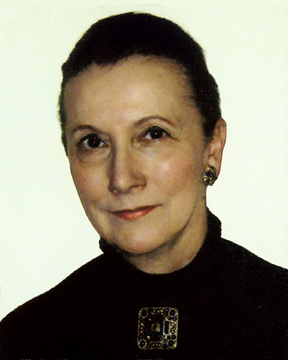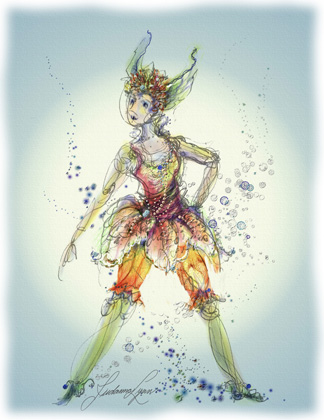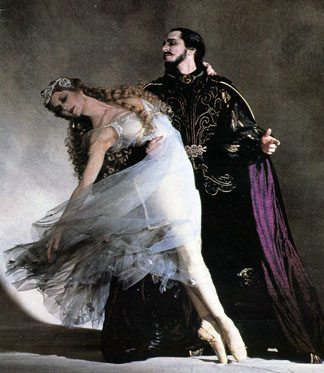Judanna Lynn for whom Cloth Dances!
By Francine L. Trevens
ART TIMES Sept/ Oct 2010
 Judanna Lynn’s self photographed portrait Judanna Lynn’s self photographed portrait |
There are many careers for aficionados of dance besides that of dancer. Here’s a woman, Judanna Lynn, who made her career after seriously studying and dancing ballet for years) as a costume designer for dance. Asked why she switched, she said: “I never saw myself as ‘switching to costuming’ because I never saw the various aspects of the art as separate.
“I had extraordinary ballet teachers in Minneapolis, Anna Adrianova and Lorand Andahazy, former dancers with the de Basil Ballets Russes. They didn't limit ballet artistry to the person doing the physical steps. The space surrounding the arabesque was as important in telling the story as the step itself. Ditto the lighting, decor and costumes: Equal contributors along with the music in creating the choreographic intent.
“In class, from the ‘babies’ to ‘professionals,’ we were exposed to paintings, poetry, and frequent guest artists from the Minneapolis Symphony. One of my favorite was Robert Tweedy, the timpanist, who not only would play his drums for us but also improvise amazing melodies on the piano.
“I was amazed at the beauty of Mr. Andahazy’s paintings hung in the school foyer, especially inspiring to me because I liked to paint, too.
“There was an amazing scenic painter living in Minneapolis at the time, Victor Hubal, whom the Andahazys knew and enlisted to paint the magnificent scenery for the various productions they mounted: Scheherazade (with reproduction of the Bakst scenery), ‘Sleeping Beauty,’ ‘Les Sylphides,’ etc. Also original productions of their own choreography: I remember being a ‘worm’ in ‘Cargo of Lost Souls,’ a comment on Dante's Inferno, complete with ‘black light’ and marvelous stage effects that I'm now seeing here as if something new is being invented. All this is by way of saying I saw the various aspects of the art as part of a seamless whole.”
Later, Judanna moved to San Francisco and danced with Alan Howard and the Pacific Ballet and the San Francisco Opera Ballet, again finding herself among great musical artists, directors and designers. This was an especially rich time in the history of the San Francisco Opera, with Pavarotti making his American Debut, and Joan Sutherland, Alfredo Kraus, Jean Pierre Ponelle, among others.
 Judanna Lynn’s sketch of Tinker Bell for Milwaukee Ballet's "Peter Pan" which premiered this last April Judanna Lynn’s sketch of Tinker Bell for Milwaukee Ballet's "Peter Pan" which premiered this last April |
“Someone at the opera house had seen some of my drawings and knowing that I was taking a short vacation to New York City, suggested that I show my work to some working designers while I was visiting. I was very shy, I waited until the last minute before calling the long list of contacts and was so relieved just about everybody was out of town or busy. All but Ming Cho Lee. His wife, Betsy, invited me for tea and polite man that he is, he said that he thought I might have a career as a costume designer. I went home to dance, but the idea was in the back of my mind.
“As fate would have it, a bit later I had an accident in rehearsal that put an end to the dancing. I went to New York City, with the encouragement of Ming Cho Lee, got a job sewing soldier's pants for a friend who was project manager for a show Willa Kim designed. Later, I took classes at Lester Polakov's and the Arts Students League (with extraordinary teacher, Anthony Palumbo). Shortly thereafter, I became the Resident Costume Designer at the Juilliard School.”
Miss Lynn soon realized that working freelance was what she wanted to do and that has been her profession ever since. She had a bit of an edge, because: “Having been a dancer, I know what it is like to wear something that makes you feel like ‘dog's breakfast.’
"It is a musical thing as well. Cloth moves, ‘dances,’ if you will. Chiffon does not move the same way as cotton or tulle when you do a pirouette, for instance. Cloth is as much a visual expression as the person moving it. Does it lag behind the ‘note’? stop abruptly, etc? How does this affect the choreographic intent?
“And what about color? I ‘see’ music in color if I close my eyes. I thought everybody did. It never occurred to me that was rather unique, until a few years ago in a discussion with some friends.”
 Houston Ballet's Susan Cummins and Timothy O'Keefe in "Dracula" Photographer: Drew Donovan. Houston Ballet's Susan Cummins and Timothy O'Keefe in "Dracula" Photographer: Drew Donovan. |
Judanna has designed for most of the major ballet companies in the United States, including Ballet West, Pacific Northwest Ballet, Hartford Ballet, Washington Ballet, Atlanta Ballet, Pennsylvania Ballet, Louisville Ballet, Hubbard Street Dance Company, Jose Limon Dance Company and the Julliard School. Charles Strouse, composer of Annie, engaged her to design Lyle, his new musical. Since designing for BalletMet Ms. Lynn has created another Nutcracker for Atlanta Ballet. Ms. Lynn also is a painter whose work has been shown at the Rizzoli and Miniatura Galleries in New York City and at the Philadelphia Museum of Fine Art.
She has traveled extensively doing costuming, to China, Poland and Mexico and remarked, “I very much enjoyed Hong Kong when I was working there for Disney a couple of years ago. The energy, ambition and attention to details were impressive. And of course, the beauty of the countryside and the grace of the Chinese I met.”
She was impressed with the Asian costume building techniques, and the expertise of various people who worked on each costume with precision and artistry impressed her.
Still she claims one of her greatest satisfactions has been working with children, especially with all those "Nutcrackers" she designed.
“I was so fortunate to have had those marvelous, inspiring ballet teachers, they taught me so much about discipline, beauty and the wisdom that can be learned through the arts and applied in adult life to just about any endeavor and circumstance. It is so rewarding to have the opportunity to pass down what I was given.”
Her advice to aspiring designers, “Get a good liberal education. Study literature, art, history and philosophy. Before you ever design that costume, you have to be able to communicate with the director, on down. You need something in your head besides how to drape chiffon or paint a leotard. Learn the practical stuff by apprenticing yourself to someone you admire.”
Judanna has several exciting assignments in the works, one in the states the other in another interesting country. Who knew becoming a costume designer would be like joining the army to see the world?
(Francine Trevens’ latest book, Short Plays to Long Remember, is a 2010 Next Generation INDIE Finalist Award Winner).
